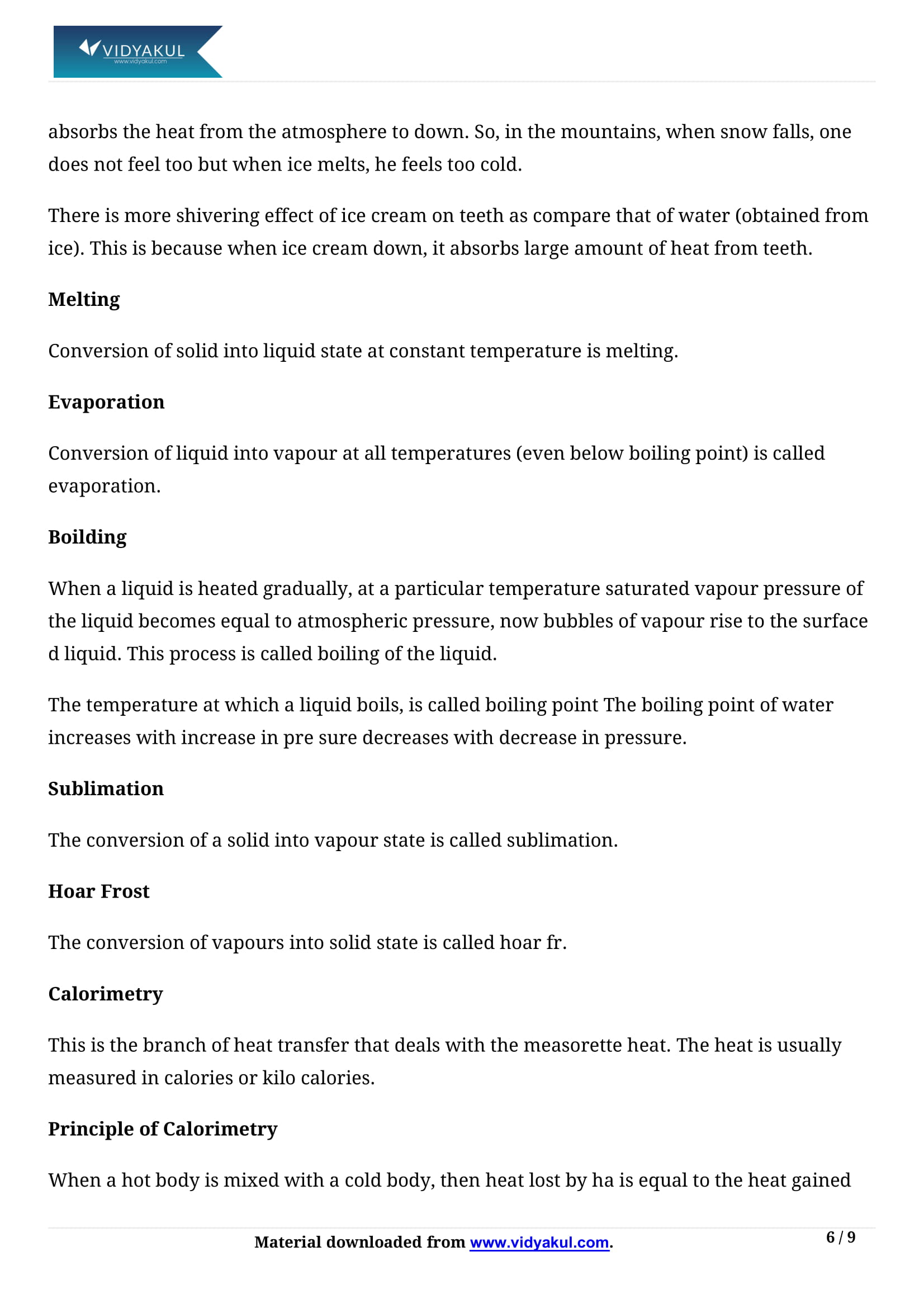Class 11 Physics Chapter 11 Thermal Properties of Matter Notes

Chapter 11 Thermal Properties of Matter
The NCERT notes are an essential learning resource for 11th-grade students. Vidaykul's expert faculty have prepared questions for students about the physics of the thermal properties of NCERT materials. Using these notes, students can easily solve all 22 questions available in the exercise at the end of the chapter. The answers to all questions are 100% correct.
Unit 11 and Physics Chapter 11 discusses temperature and heat, temperature measurement, the ideal gas equation and absolute temperature, specific heat, change of state, and more. Students should practice all of Vidyakul's text problems in order to score well on the exam. Keep scrolling to find the NCERT notes for Class 11 Physics Chapter 11.
CBSE CLASS 11th PHYSICS CH-11
Points to Remember
We have provided some of the crucial points related to Class 11 Physics Chapter 11 as mentioned below:
Energy transferred from one body to another body due to their temperature difference is known as heat.
The temperature of a body is a physical quantity that determines whether the heat energy flows from one body to another or not. The temperature of a substance is the measure of the average kinetic energy of its molecules.
The temperature of a substance does not change during the change of state of the substance.
Three modes of heat transfer are conduction, convection, and radiation.
Emissivity for a perfect blackbody is one.
Topics and Sub-topics
The thermal properties of materials may seem difficult for students to understand, but the concept becomes easier to understand as students continue to solve problems and questions. By practicing NCERT notes, students can analyze the nature of the questions asked on the exam.
At Vidyakul, students can find answers to all their questions in Chapter 11 of the Grade 11 Physics textbook, taking into account the latest curriculum. Students can access questions on Vidyakul for free to practice and get good grades.
Below-mentioned is the list of topics present in Class 11 Physics chapter 11.
Few Important Questions
What is ‘Thermal Equilibrium’?
The condition under which two substances in physical contact with each other exchange no heat energy is known as thermal equilibrium.
What is ‘Conductivity’?
The quality or power of conducting or transmitting heat/electricity is called conductivity.
What is ‘Emissive power’?
Emittance (or emissive power) is the total amount of thermal energy emitted per unit area per unit of time for all possible wavelengths.
Practice Questions
Answer the following:
(a) The triple-point of water is a standard fixed point in modern thermometry. 2018-19 300 PHYSICS Why? What is wrong with taking the melting point of ice and the boiling point of water as standard fixed points (as was originally done in the Celsius scale)?
(b) There were two fixed points in the original Celsius scale as mentioned above which were assigned the numbers 0 °C and 100 °C respectively. On the absolute scale, one of the fixed points is the triple-point of water, which on the Kelvin absolute scale is assigned the number 273.16 K. What is the other fixed point on this (Kelvin) scale?
The triple points of neon and carbon dioxide are 24.57 K and 216.55 K respectively. Express these temperatures on the Celsius and Fahrenheit scales.
Explain why :
(a) a body with large reflectivity is a poor emitter
(b) a brass tumbler feels much colder than a wooden tray on a chilly day
(c) an optical pyrometer (for measuring high temperatures) calibrated for an ideal black body radiation gives too low a value for the temperature of a red hot iron piece in the open, but gives a correct value for the temperature when the same piece is in the furnace.
Energy transferred from one body to another body due to their temperature difference is known as heat.
The temperature of a body is a physical quantity that determines whether the heat energy flows from one body to another or not. The temperature of a substance is the measure of the average kinetic energy of its molecules.
The temperature of a substance does not change during the change of state of the substance.
Three modes of heat transfer are conduction, convection, and radiation.
Emissivity for a perfect blackbody is one.
What is ‘Thermal Equilibrium’?
What is ‘Conductivity’?
What is ‘Emissive power’?
Answer the following:
(a) The triple-point of water is a standard fixed point in modern thermometry. 2018-19 300 PHYSICS Why? What is wrong with taking the melting point of ice and the boiling point of water as standard fixed points (as was originally done in the Celsius scale)?
(b) There were two fixed points in the original Celsius scale as mentioned above which were assigned the numbers 0 °C and 100 °C respectively. On the absolute scale, one of the fixed points is the triple-point of water, which on the Kelvin absolute scale is assigned the number 273.16 K. What is the other fixed point on this (Kelvin) scale?
The triple points of neon and carbon dioxide are 24.57 K and 216.55 K respectively. Express these temperatures on the Celsius and Fahrenheit scales.
Explain why :
(a) a body with large reflectivity is a poor emitter
(b) a brass tumbler feels much colder than a wooden tray on a chilly day
(c) an optical pyrometer (for measuring high temperatures) calibrated for an ideal black body radiation gives too low a value for the temperature of a red hot iron piece in the open, but gives a correct value for the temperature when the same piece is in the furnace.
Learn More about the same in Class 11 Physics Chapter 11 Thermal Properties of Matter NotesPDF.
Download this solution for FREE Download this PDF












